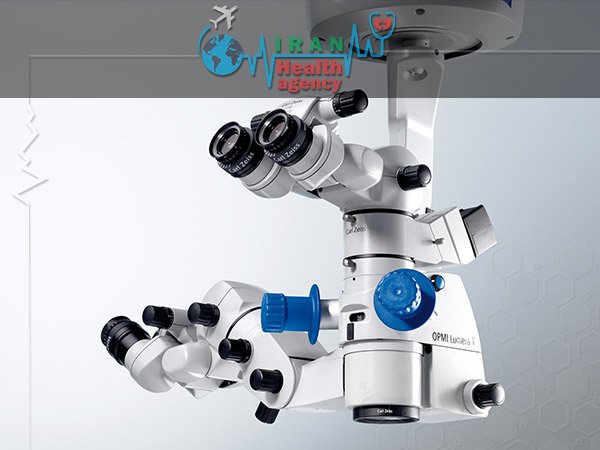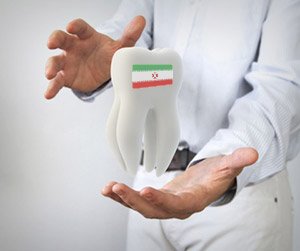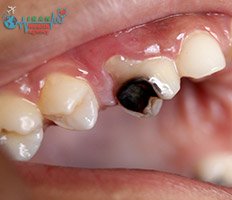Endodontics in Iran
Root canal treatment in Iran , How much does a root canal treatment cost in Iran? Find the answer to all your questions about Endodontics in Iran here
“LOVE conquers all things except poverty and toothache” Mae west says.
When the tooth becomes infected and damaged needs to be treated with a treatment called dental implantation or root canal treatment.
Why should I trust Iran for root canal therapy?
Root canal treatment in Iran such as the other cosmetic and general dental treatment, is performed at very affordable cost having 100 percent positive result.
Root canal treatment is done in the hand of the best dentist in Iran Tehran, Mashhad, shiraz, Tabriz and Ahvaz.in terms of internationally standardized dentistry clinics and centers and also availability of board-certified general and cosmetic dentist, Iran has turned to a popular destination for dental tourism.
Root canal treatment cost in Iran is another money saving reason that persuades health tourist to trust dental services in Iran.
Medical tourism in Shiraz in another ways to use root canal treatment in Iran.

How much does a root canal treatment cost in Iran?
There are multiple factors affecting the Final price of root canal treatment in Iran, the factors such as dentist reputation, case severity, number of teeth and destination.
But the average cost of root canal treatment in Iran is around 150$_250$ for per tooth.
When should a root canal treatment be done?
Root canal treatment or technically called Endodontics is essentially performed when inside the tooth becomes infected and damaged.
The tooth Internal cabin that contains blood vessels and nerves is called a pulp. Actually If the pulp is damaged, inflamed and infected for any reasons, the only way to cure and save the tooth is to empty out the pulp cavity,
During the procedure, entire the pulp cavity, from the root canal to the top should be drained, cleaned, disinfected and then Filled.
How is the root canal treatment procedure in Iran?

There are 7 steps for root canal treatment in Iran, explained one by one below:
First step: Isolating the tooth by using a rubber sheet inside the mouth
Firstly, the mouth gets numb and then the dentist separates the tooth from the mouth by using a rubber sheet.
Punching the rubber sheet, which in most cases is made of latex in order to the tooth exits, while the rest of the teeth are behind it.
Indeed, this action prevents the salivary liquid from flowing to the tooth which is under the treatment.
What is the importance of tooth isolation in dental treatments?
Tooth decontamination is One of the most significant purposes of root canal therapy, on the other hand the tooth must remain dry and clean.
Since saliva contains bacteria and other particles, the rubber acts as a barrier against saliva to prevent contamination and particles from entering inside tooth.
Rubber placement is part of standard root care necessary to be done. Ask your dentist if it has not been used in your treatment.
Step 2: Make a hole in the tooth

for starting the treatment, the dentist must have access to the pulp cavity inside the tooth, therefore a tooth crown should be punctured. This step is called an access hole creation.
The dentist employs a dental drill to make a hole through the pulp cavity. Actually this whole is agate of treatment.
In the case of the rear teeth, the access hole is created at the outer surface and at the front teeth this hole is created at the dorsal surface.
In duration of creating an access hole, the dentist also removes all tooth decay and separates fragile, loose and filled parts from tooth.
At this time, the mouth is numb, the rubber is inside the mouth and everything is prepared for treatment. As previously mentioned, tooth numbness does not significantly impair the sense of pressure, so you can feel the shake of dental drill completely. But this is a mild feeling and without pain.
If you feel pain at any stage of treatment, inform the dentist, as you should not feel pain at all therefore The dentist is supposed to use more anesthesia.
Reading this article in wikipedia can be useful for you
The Usage of surgical microscope

In standard treatment, After the dentist enters the tooth, , the floor of the cavity is examined using a pulp surgical microscope. This tool helps the dentist identify the entire root canal to find all the minor and subsidiary canals that are not visible to the naked eye.
Using a microscope increases the possibility that the dentist will find and treat the entire root canals, thus increasing the probability of successful treatment.
In fact, microscope is Particularly important in tooth cases where small ducts are expected to be present in the root and need to be identified, such as large mill teeth, small mill teeth, mandibular front teeth, and teeth having calcified root canal.
However, keep in mind that these modern tools and equipment also increase the cost of treatment and often the general dentist does not have such tools.
Stage Three: Measuring tooth length
The goal of the dentist is to treat the entire length of the root canal, not beyond. this is not only an important part of the root canal treatment, but it also helps minimize postoperative pain and prevent treatment failure.
Therefore, the dentist should measure the length of each root canal. The size is usually about half a millimeter.
How is the root canal length measured?

There are two common techniques for measuring the root canal length:
X-ray image
The traditional is the usage of an X-ray image by inserting the file into the root canal. The file is a hand-held ice-breaker tool with a flexible blade to be fitted inside the root canal without damaging it.
Since the files used for the root canal are metallic, they are clearly identifiable in the X-ray image. The length of the root canal and the whole tooth can be measured by reading the marks engraved on the file.
An X-ray image is used to verify the correct position of the file in the tooth to ensure that the file go through the full length of the canal and reaches the root tip.
Dental veneer in iran
see also dental veneer in iran with amazing cost and condition
B- Electronic method
Measuring the length of teeth using electronic devices has become more common in recent years.
The dentist attaches one of the wires to the file inside the tooth and inserts the second wire into the inner surface of the patient’s lips for creating a complete electrical circuits
When the dentist inserts an electrical device it into the root canal, the device shows changes in electrical resistance, and since the root canal area is insulated, the tip of the file gets closer to the conductive tissue surrounding the root. The beep sound or the device display indicates that the file reaches the end of the channel (root tip).
Note that the length measurement is based on the numbers engraved on the file. The electronic device only shows when the file is to the root tip.
Stage 4: Cleansing and shaping the root canal
During the tooth cleaning process, the living or dead nerve tissues are removed and the bacteria are destroyed and generally all particles and toxins inside the tooth are discharged and cleansed.
The root canal is then shaved, shaped and enlarged to ensure that the entire wall is free of contamination and bacteria. The root canal walls are shaped in such a way that the duct shape is ideal for filling.
Tooth root wall shaping with file:
At this point, the dentist will try to keep the healthy structure of the tooth as intact as possible and not remove a large portion of the tooth in order to maintain the tooth integrity.
The major part of root canal treatment is done by utilizing the files in different sizes.
The dental files are sharp and their body surface is rough. In fact, these tools have miniature cylinder head. The dentist shakes the file inside the tooth with reciprocating and rotational movements. As a result, walls of the tooth are shaved and cleaned.
These gestures are done with files of different sizes. Usually at least six files, each one larger than the previous one, are used. The order of using files is from smaller to diameter to gradually expand the root canal.
Since some of the contaminants in the tooth are trapped in the root canal wall therefore They will be thoroughly only by using files and fulfilling the root canal enlargement process.
One of the important steps in cleaning and shaping the root canal is the pulp washing up. The dentist is supposed to regularly wash the inside of the tooth to remove any particles and contaminants. Different solutions may be used for this purpose, the most common being sodium hypochlorite that One of the benefits of this product is its disinfectant
Step Five: Filling the tooth

The empty space of tooth is now ready to fill. In some cases, the dentist fills it with special ingredients immediately after the tooth is cleaned, and in some other cases the dentist may find it appropriate to wait a week for everything to go well.
If the latter is the case, the dentist should place temporary fillers inside the tooth to prevent contamination.
Fillers in root canal treatment
The most common tooth filling material in root canal therapy is a plastic resin called Gatapressa. Gatapressa is used in conical shapes of different sizes (the sizes of which are quite consistent with the size of dental files).
Filling the tooth with the Gatapressa cones
To fill the tooth, a gutta-percha cone is first inserted into the root canal. The first Gatapressa cone is very important because it has to travel the full length of the root canal and reach the root tip of the tooth. Then the other cones are added until the entire conduit is completely filled.
The dentist may soften Gatapura’s by contacting a hot device. This action allows the material to be compact and better matched with the inner shape of the tooth. Another way is to put the gatapressa in the tooth with a special gun. It resembles a thermal glue gun, which a solid tube of Gatapura is heated and melted inside the gun and then compressed into a tooth.
Temporary filler
Step Six: Temporary Filler
After the dentist has filled the tooth, a temporary filler is placed on the crown. This filler closes and seals the access hole created in the crown. At this point, the root canal treatment is complete.
Stage 7: Tooth restoration

Although the root canal therapy is over here, the tooth is still working.
To strengthen the damaged tooth structure and also to be able to re-feed with this treated tooth, you need to have a restoration material like dental veneers. The type of repair depends on the conditions.
The restoration may be applied to the tooth immediately after, or shortly after, the root canal treatment.
What to do or not to do after a root canal treatment in Iran?

- Take care of your teeth and gums well.
- You may need to see your dentist in order to check the treated teeth by the usage of x-ray.
- Make sure all signs of infection are gone.
- Every two-year check-up by a dentist is necessary.
- Put value on regularly and daily care, including tooth brushing twice a day, which fights germs for 12 hours.
- do not chew or bite though things until the tooth is fully restored
How long does a root canal last?
In most cases, the lifespan of a tooth treated by a root canal treatment is the same as the other healthy teeth.
However, in some cases, the tooth may not heal properly or become infected again. Sometimes the tooth may be in pain for several months or several years after successful root canal therapy, in such cases, endodontic treatment should be repeated again to save the tooth. However, the rate of success of root canal treatment is very high.
What Causes Teeth Infection after a root canal treatment?
Injuries and new incisions, tooth decay or loosening, cracking or fracturing of tooth fillers are among the factors that lead to bacterial infiltration and tooth infection. In some cases, the endodontist may find that the tooth has a sub-root or a very narrow or curved root that has not been seen or treated completely in the previous root canal process.
Does a root canal treatment work with any types of teeth?
In most cases, root canal therapy can be performed. However, sometimes it is not possible to save a tooth because the root canal is unavailable, the root is severely fractured or damaged, or the tooth has insufficient support for the jawbone or cannot be repaired. However, in terms of many advances in the field of endodontic treatment, in most cases root canal is possible. Endodontic surgery may be a better option if root canal is not effective and efficient.
What cause pain after root canal treatment ?

Most people still have dental sensitivity and pain a few days after the root canal treatment. There are several reasons:
The tissue around the gums remains swollen or inflamed: Even if the dentist removes the nerve root, there is still a small nerve in the muscles and tissue around the tooth. When the area becomes inflamed, such as after a dental procedure, these nerve terminals can also cause some discomfort.
Damages caused by the devices: A dental device that is not used properly to clean the root canal may damage sensitive tissues around the tooth.
When temporary fillings are higher: If the dentist does not straighten the fillings, and they are slightly above the surrounding teeth, it will put more pressure on the mouth when biting, causing the tooth Pain.
In most cases, the sensitivity and discomfort caused by the nerve will disappear after a few days. Otherwise, you may need to apply some home remedies or see a dentist.